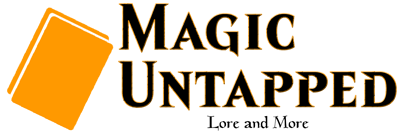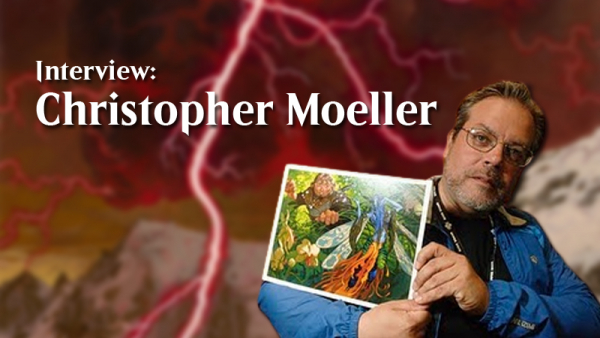Magic: The Gathering artist Christopher Moeller joins Magic Untapped for a Q&A.
For years, the Mt. Lebanon, Pennsylvania, artist, Christopher Moeller, has done artwork all across the genres of fantasy, sc-fi, and pretty much any related genre. This, of course, includes Magic: The Gathering, but also the world of comics, graphic novels, and games.
We chatted a bit with Christopher about his career and some of his Magic: The Gathering card art.
Magic Untapped: What inspirations and influences in your life drove you to becoming a professional artist?
Christopher Moeller: As a youngster, I was always interested in illustrating fantasy books (Narnia, Lord of the Rings, John Carter of Mars) and science fiction (Star Trek, Star Wars, Asimov). Somewhere in high school (like 1980-81), I discovered the fantasy book section at Walden Books (Frazetta, Boris, Whelan, the Bros. Hildebrandt), and got a subscription to Heavy Metal magazine.
In 10th grade, I remember seeing the seniors in art class preparing their portfolios for college and the lightbulb went off… I can do this? I’m gonna do this!!! It was a thrill.
MU: How did you get your start with Magic: The Gathering?
CM: I got to know the master illustrator Brom when he lived in Pittsburgh for a few years. When I went out to San Diego Comicon one year, Brom and Ron Spears, then AD of Magic, came by my table and looked at my work. Ron asked if I’d like to try my hand at a few Magic cards and I said sure. That was my intro: my very first illustration for Ron (and Magic) was Expunge from Urza’s Saga.
MU: How long do you typically spend on a piece?
CM: Sketches and back and forth takes a few days. Once the sketch is approved, the actual painting takes 2-3 days.
MU: Back in the early 1990s, you did artwork for a comic book adaptation of Anne Rice's Interview with the Vampire. How was it creating artwork for such an iconic piece of literature?
CM: That was one of my early breaks. My first comic was Rocketman: King of the Rocketmen for the same publisher (Innovation Comics). Based on that work, they asked me to finish up the run on Anne Rice’s book. I had to stop doing the interiors after a while, but continued doing covers to the end. It was a great experience.
MU: Over the years, it's fairly common for Wizards of the Coast to commission new artwork for reprints of old cards, and yet your artwork for the card Shelter seems to be standing the test of time. What is it about that art that you think gives it its staying power?
CM: Ha ha! I’m not sure? It’s one of my more successful paintings, and remains one of my (and players’) favorite pieces. It’s sexy, evocative, and communicates the spell’s function well I think.
MU: Have you ever tried a more "out of the box" approach to a card where you try a new perspective or style?
CM: Oh all the time. Every illustration I do starts with a question “what’s the object of this painting?” followed by an answer “this is the best way I can think of to achieve that.”
Early on that can lead you into coming up with some very interesting solutions. Eventually, though, the pressure to complete paintings incentivizes you to answer every question the same way, that’s a problem… the art becomes repetitive and less fun to paint. I began painting in oils (versus acrylics) as a way to expand my image making potential.
I eventually left Magic when I felt like I had pretty much discovered all of the answers I was going to find.
MU: Do you have a favorite art medium? If so, does it make fantasy artwork harder or easier to create?
CM: My medium of choice quickly became acrylics. I find them to be super flexible and they suit my painting style, which is unpremeditated and able to turn on a dime. As for harder/easier, basically anything that isn’t digital is harder.
Once photoshop and procreate came into broad use, traditional mediums started to phase out rapidly. Digital painting has built-in tools that make it infinitely faster and more powerful than traditional mediums.
MU: Can you tell us a bit about your process? That is, how to you go from idea to a finished art piece and does that process change depending on the work being done?
CM: The process starts with a phone call or email.
From that, I ask questions, particularly if it’s for a project I’ve never worked on before. Then I do a number of small sketches, just pencil thumbnails a few inches on a side so we can begin talking about composition. Once that’s settled, I’ll do a more finished sketch, including costume details, fully developed backgrounds, etc…
Once that’s signed off on, I enlarge the sketch onto illustration board and start painting: broadly at first, then, once the textures, values and colors are where I want them, I begin to refine the shapes and edges until the piece feels resolved.
MU: What kinds of things are more tricky for you to create (landscapes, people creatures, etc.)?
CM: People (specifically faces and hands) are the hardest things to paint well, because people know them so well. If a horse is out of proportion, people don’t tend to notice, but if an eye is off on a face, people immediately spot it and it bugs them.
MU: In addition to creating artwork for Magic: The Gathering, you've also done a good amount of work for other games such as the World of Warcraft trading card game, as well as for the tabletop game Axis & Allies.
How does creating non-MTG art differ for you compared to your Magic pieces?
CM: Comics, Magic, Gaming… it’s all part of that same process: "what’s the object?" followed by “how can I answer that?”
One of the great things about being an illustrator is the broad variety of projects you get to work on. I’ve done superhero graphic novels (written them and painted them, talk about wearing lots of hats!), I’ve painted posters of Iron Man and the Hulk, done runs of painted covers for Batman, Lucifer, [and] created playing pieces for Battletech.
There is always something new to explore.
MU: Do you have any new projects in the pipeline that Magic fans and Christopher Moeller fans in general would be interested to learn about?
CM: Since I retired I’ve been starting a new career as a war-game designer! I’ve got two games in publication right now, both from Compass Games: Napoleon’s Eagles (a card game set in the 1800s) and Brothers at War (a board war-game featuring four battles of the American Civil War).
A sequel to Napoleon’s Eagles is in the pipeline, and I’ve just announced a fantasy war-game called Burning Banners that Compass will be releasing via Kickstarter in the next year. All these games are 100% my art and design, which is just an amazing thing to be able to do.
I design the games, but then I also get to design the boxes, the pieces, the maps, the logos, the cards… it reminds me of writing and painting comics. A lot of work but never boring.
Thanks to Christopher for participating in this interview.








